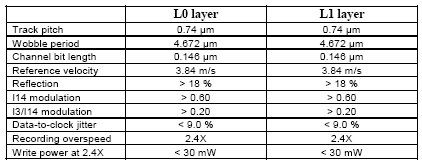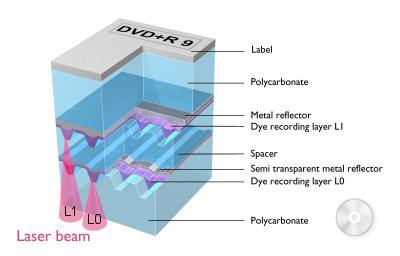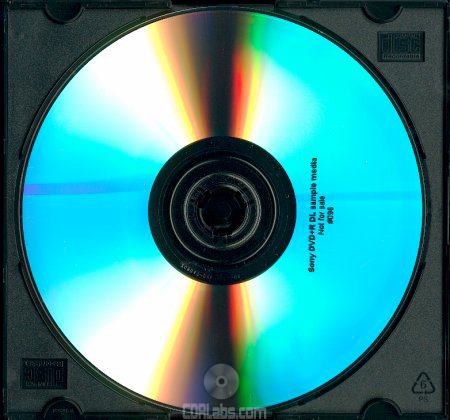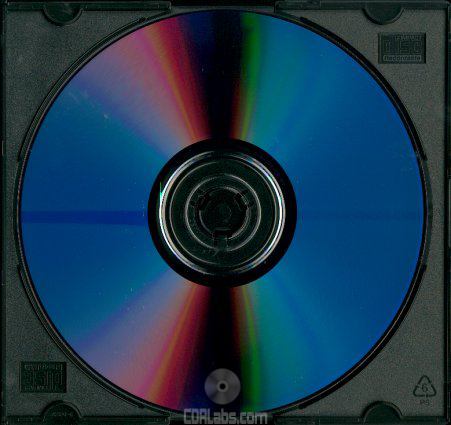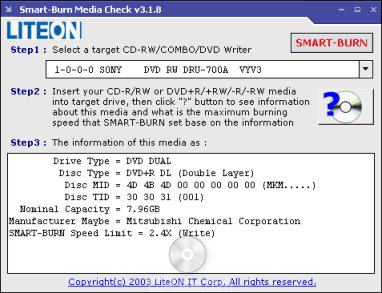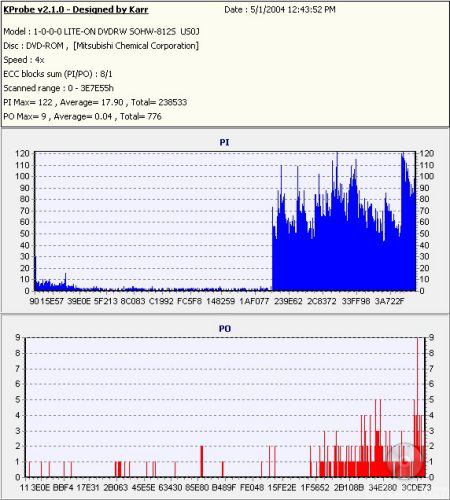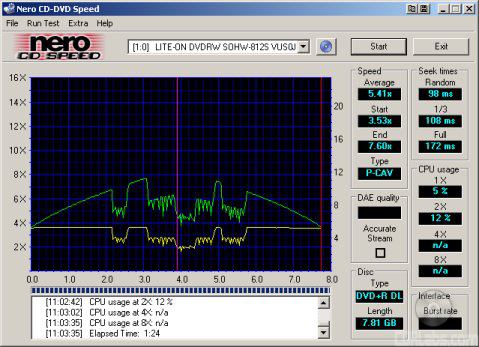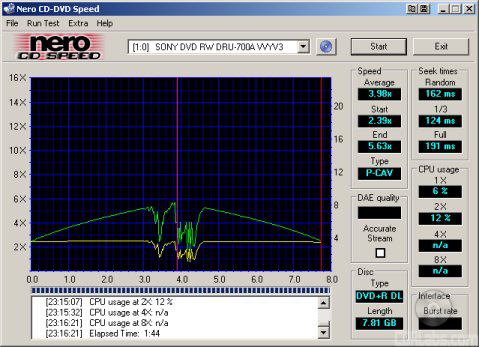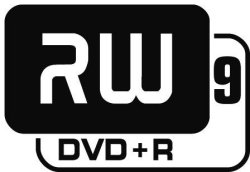
Last fall, the DVD+RW Alliance dropped a bombshell on the optical storage industry when they announced Double Layer DVD+R technology. Developed by Philips Research and MKM (Mitsubishi Kagaku Media), this new technology increases the capacity of DVD+R media from 4.7GB to 8.5GB. While not quite double the capacity, it does allow users to store up to 8.5GB of data, 4 hours of DVD quality video or 16 hours of VHS quality video without the need to flip over the disc.
Before this, the concept of double layer recordable media was nothing more than a pipe dream. While double layer DVD-ROM's have been around for a number of years, there were a number of things that kept this technology from being applied to recordable media. One hurdle in particular was the media itself. How do you keep one layer from interfering with the other while recording? More importantly, how do you ensure that the discs will be playable on most existing DVD players?
Finding answers to these questions wasn't easy. It took Philips two years to work out the details and that was with the help of MKM. The eventual solution was to use two organic dye recording layers, separated by a transparent spacer, about 55µm thick. The first, or lower, recording layer (L0) is backed by a thin silver-alloy. This semi-reflective metal has a reflectivity of about 18%, keeping it in compliance with the double layer DVD-ROM standard. This layer also lets the laser beam pass through so it can focus on the second, or upper, layer (L1). Because the first layer absorbs and reflects about half of the laser's power, the second layer has higher power sensitivity and greater reflectivity (> 50%). Even then, the effective reflection is only about 18%, the same as the first layer.
Double layer DVD+R discs also use a wobbled pre-groove to control the rotation speed and provide the addressing information. While single layer discs have this molded into the polycarbonate base, each layer has their own wobbled pre-groove. When a double layer disc is inserted into a drive, the laser will focus on one of the layers and try to detect the ADdress In Pre-groove (ADIP) signal. With this, the drive can determine the number of layers and, if it's a double layer disc, which layer it has focused on. From here the drive will try to determine whether or not the disc is blank, partially recorded, or finalized.
The recording process is also a little different with double layer DVD+R media, but we'll touch on that later in this article. For now, let's take a brief look at Sony's new double layer DVD writer, the DRU-700A.
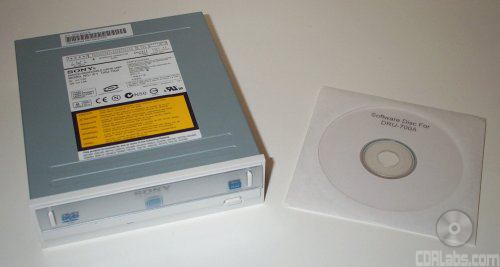
The DRU-700A Sony sent us was a pre-production sample. However, Sony assured us that there should be little, if any, difference between it and the production drives. Along with the drive, they sent us a CD containing a software suite from Ahead Software. This suite includes Nero Express 6, NeroVision Express 2, InCD 4, Nero ShowTime, Nero BackItUp, Nero ImageDrive, Nero MediaPlayer, Nero Cover Designer and the Nero Toolkit..
Physical Features:
The drive we received from Sony was manufactured in March of 2004 and had firmware version VYV3.

From the front, the DRU-700A looks very similar to Sony's other DVD±RW drives. This is primarily due to the silver colored tray. If white and silver aren't exactly your colors, you're in luck. Sony is also planning on including a black replacement bezel with the drive. As you can see, the DRU-700A also has its share of logos. Along with the large Sony logo, you can see a few showing support for the DVD-R/RW and DVD+ReWritable formats. Oddly enough, our test unit did not have a Double Layer logo. However, this might be due to the fact that it was an early sample.

It shouldn't be too surprising that the DRU-700A does not have a headphone jack or volume control. Like most manufacturers, Sony has cut costs by removing these little used features. Looking at the front of the drive you can see that the DRU-700A also has one LED. Itlights up orange whenever the drive is reading or writing.
The rear of the DRU-700A looks very similar to some of the other Lite-On based drives we've reviewed. By looking at the picture below you can see the drive's IDE interface, power connector and analog audio output connector.

Starting from the left of the IDE connection you'll see the jumper switch for master, slave and cable select. Next to the jumper block is the analog audio connector. The connector on the far left is the digital audio output.
Technical Specs:
The specs below have been taken from Sony's website and the documentation that came along with the drive.
| Sony DRU-700A 8x DVD±RW | |
| CD Write Speeds | 40x (CAV) 32x, 24x (P-CAV) 16x, 8x (CLV) |
| CD Rewrite Speeds | 24x (Z-CLV) 16x, 10x, 4x (CLV) |
| DVD Write Speeds | 8x, 6x (Z-CLV), 4x, 2.4x (DVD+R) 4x, 2.4x (DVD+RW) 2.4x (DVD+R DL) 8x, 6x (Z-CLV), 4x, 2x, 1x (DVD-R) 4x, 2x, 1x (DVD-RW) |
| DVD Read Speeds | 12x Max (DVD-ROM Single Layer) 8x Max (DVD-ROM Dual Layer) 8x Max (DVD-R/RW) 8x Max (DVD+R/RW) 6x Max (DVD+R DL) |
| CD-ROM Read Speed | 40x Max |
| DAE Speed | 40x Max |
| Buffer Size | 2 MB |
| Random Access Times |
160 ms (CD) 200 ms (DVD) |
| CD Formats | CD-DA CD-ROM CD-ROM XA Video CD Photo CD CD-Text CD Extra Multi-Session |
| DVD Formats | DVD-ROM DVD-Video DVD+R DL DVD+R/RW DVD-R/RW |
| CD Recording Modes | Track At Once Session At Once Disc At Once Packet Writing |
| DVD Recording Modes | Random Access Write Sequential Write |
More Features:
By looking at the Nero screenshot below, you can see that the drive is identified as a "SONY DVD RW DRU-700A".

Nero also shows that the DRU-700A has a maximum CD writing speed of 40x and a 2048KB buffer. This buffer is also backed up by Sony's Power-Burn buffer underrun protection. According to Nero, the DRU-700A can write CD-Text and overburn.
Here is a screen shot from Nero's InfoTool. This program queries the drive to see what its reading and writing capabilities are. InfoTool had no problems detecting the DRU-700A's maximum reading and writing speeds, recording modes, buffer underrun protection and 2MB buffer. The only things Sony's new drive doesn't support are DVD-RAM and Mt. Rainier.
InfoTool also shows that the DRU-700A is a RPC-2 DVD drive. This means that the drive's region is stored in the firmware. The drive's region can be changed five times and after that it cannot be changed anymore.
While InfoTool gives us a quick glance at the DRU-700A's features, DVDINFOpro provides a little more information on some of the drive's reading and writing capabilities. By looking at the screenshot above you can see that Sony's new drive can both read and write DVD+R DL media.
Now that we've taken a look at the Sony DRU-700A, let's see how it performs when writing to DVD+R DL discs.
Sony sent us a few DVD+R DL discs so we would be able to run some tests with the DRU-700A. By looking at the pictures below, you can see that double layer media doesn't really look any different than single layer discs. The dye color is very similar and the thickness of the discs is even about the same.
The DVD+R DL discs we received were manufactured by Mitsubishi Chemical Corporation. This really isn't too surprising considering they helped Philips develop this format. While Mitsubishi is expected to be the first company to offer DVD+R DL media, other manufacturers are expected to quickly follow suit once the technology takes off.
Looking at the DVDINFOpro screenshot above, you can see that DVD+R DL media uses an opposite track path, or OTP. What this means is that the drive starts writing at opposite ends of the disc, depending on the layer. For example, when writing to the first layer (L0), the drive starts at the inside of the disc, or hub, and moves outwards. When writing to the second layer (L1), it goes the opposite direction. It starts at the outside rim of the disc and move inwards, toward the hub. By doing it this way, a DVD player can quickly jump to the second layer when the end of the first layer is reached.
 |
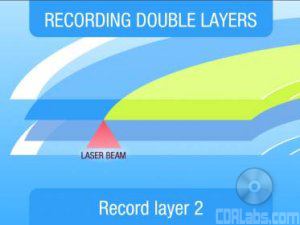 |
Within the last few months, a number of software companies have announced support for DVD+R DL media. Along with Ahead Software, companies like Roxio, Ulead, Sonic and VSO-Software have pledged support for this new technology. For this article though, we're going to focus on Ahead Software's Nero 6.
When you insert a double layer DVD+R disc into a drive like the DRU-700A, Nero will automatically adjust the maximum size of your compilation. Looking at the screenshot above, you can see that the status bar along the bottom goes all the way up to 9000MB. The status bar is also divided up into two colors (blue and yellow) to help show how full each layer is.
Writing First Layer
Writing Second Layer
While it took about 40 seconds before the DRU-700A actually started writing to the disc, the entire process went without a hitch. Switching between layers was also smoother than I expected. Sony's new drive went from one right to the other without even a hiccup.
Writing to DVD+R DL media isn't exactly the fastest process in the world. With a maximum writing speed of 2.4x, it took the DRU-700A about 44:35 to write 8001MB of data. If I would have written the same data to two single layer discs at 8x, it would have taken less than 18 minutes.
Right away, I ran into a problem when testing the writing quality of double layer DVD+R discs. Normally, when testing with KProbe I use two Lite-On DVD writers, the LDW-401S and the LDW-811S. Unfortunately, neither drive was able to recognize Mitsubishi's DVD+R DL media. After talking to Sony, I was able to get a little more information on this:
"Other burners, that check disc ID codes, won't recognize a DVD+R DL disc because they don't have the DVD+R DL disc ID code in their firmware. Even when a disc has been recorded and finalized, other burners still look for a media code and generally will eject a disc without one. Sony has recognized this and will be making a firmware upgrade available in early May that allows Sony's 510/530 customers (500 most likely as well) to read/play a finalized DVD+R DL disc. Sony can't say how other manufacturers will handle this, however, we don't expect that many users will be playing back discs in other burners."
Going by Sony's comments, it sounds like double layer DVD+R discs aren't as compatible as many have thought. To get around this problem, I tested the writing quality using Lite-On's new 8x DVD±RW, the SOHW-812S, and the Sony DRU-700A. Neither drive had problems recognizing Mitsubishi's DVD+R DL media.
The test results varied a lot. Not only from disc to disc or from drive to drive, but from one test run to another. The results shown below are a good example of what we saw on average.
With the SOHW-812S, the number of PI and PO errors stays very low until it hits the second layer. At this point, the errors jump up considerably. While the number of PI errors is within acceptable limits, there are a few cases where the PO errors are a little higher than they should be (> 4). The results aren't nearly as good with Sony's new drive. While still acceptable, the number of PI errors is fairly high throughout the entire disc. The number of PO errors is also much higher, in some cases jumping up as high as 20.
I also tried reading the discs using Nero CD-DVD Speed. In theory, if the number of PO errors is as high as indicated by the DRU-700A's KProbe results, both drives should have problems reading back the discs.
As you can see, both drives had their share of problems reading Mitsubishi's DVD+R DL discs. While I expected a few slow downs when reading the second layer, they also occurred during the first layer. This makes me think that the Sony's KProbe results are probably a little more accurate than the Lite-On's, at least with DVD+R DL media. Even then, without more double layer media and drives to test with, I'm not really prepared to put my money on one or the other quite yet. A lot more testing still needs to be done.
While the results shown here aren't exactly favorable, you need to keep in mind that our tests were run using a pre-production drive and early samples of Verbatim's DVD+R DL media. Hopefully the results will be much better when double layer DVD+R technology goes prime time later this year.
Conclusion:
So what you say? You're waiting for blue laser technology like Blu-Ray and HD-DVD? While these technologies offer capacity much greater than DVD+R DL, it's going to be a number of years before they become mainstream and even longer before the prices come down to semi-affordable levels. Right now, Sony's Blue-ray recorders (which are only available in Japan) will set you back more than $2500 with media running about $20 a disc. Even then, it's not clear which format will win out in the end. While Blu-ray has an early lead, the DVD Forum's HD-DVD format is quickly gaining ground. In a situation like this, early adopters might find themselves with the next "Betamax".
For now though, double layer DVD+R technology has a lot of potential. While far from being speedy, the extra capacity it offers will make it a big hit among consumers, especially those looking to backup, or archive, their movie collection. Even then, this new technology isn't without its growing pains. As we've shown you here, there are still some writing quality and compatibility issues that need to be worked out. Being able to store up to 8.5GB of data on one disc doesn't mean much if existing DVD-ROM drives and DVD players can't read it. Hopefully, drive and media manufacturers will spend the next few months improving these things.
I have not seen any concrete shipping dates yet, but word on the street is that we could see double layer DVD+R drives from companies like Lite-On and Sony as early as May. However, most manufacturers seem to be waiting until June or July to ship their drives. This is mostly due to the lack of DVD+R DL media. It's been reported that manufacturers like Mitsubishi have ramped up production, but it's going to be some time before their factories can match the demand. In the mean time, expect to pay a premium for DVD+R DL media. Current estimations range from $5 all the way up to $15 per disc. Of course, we won't know until they actually start hitting store shelves later this summer.
| Double Layer DVD+R Resources |
I want to say thank you to Rebecca S., Melissa D. and the good people at Sony for helping to make this article possible.
